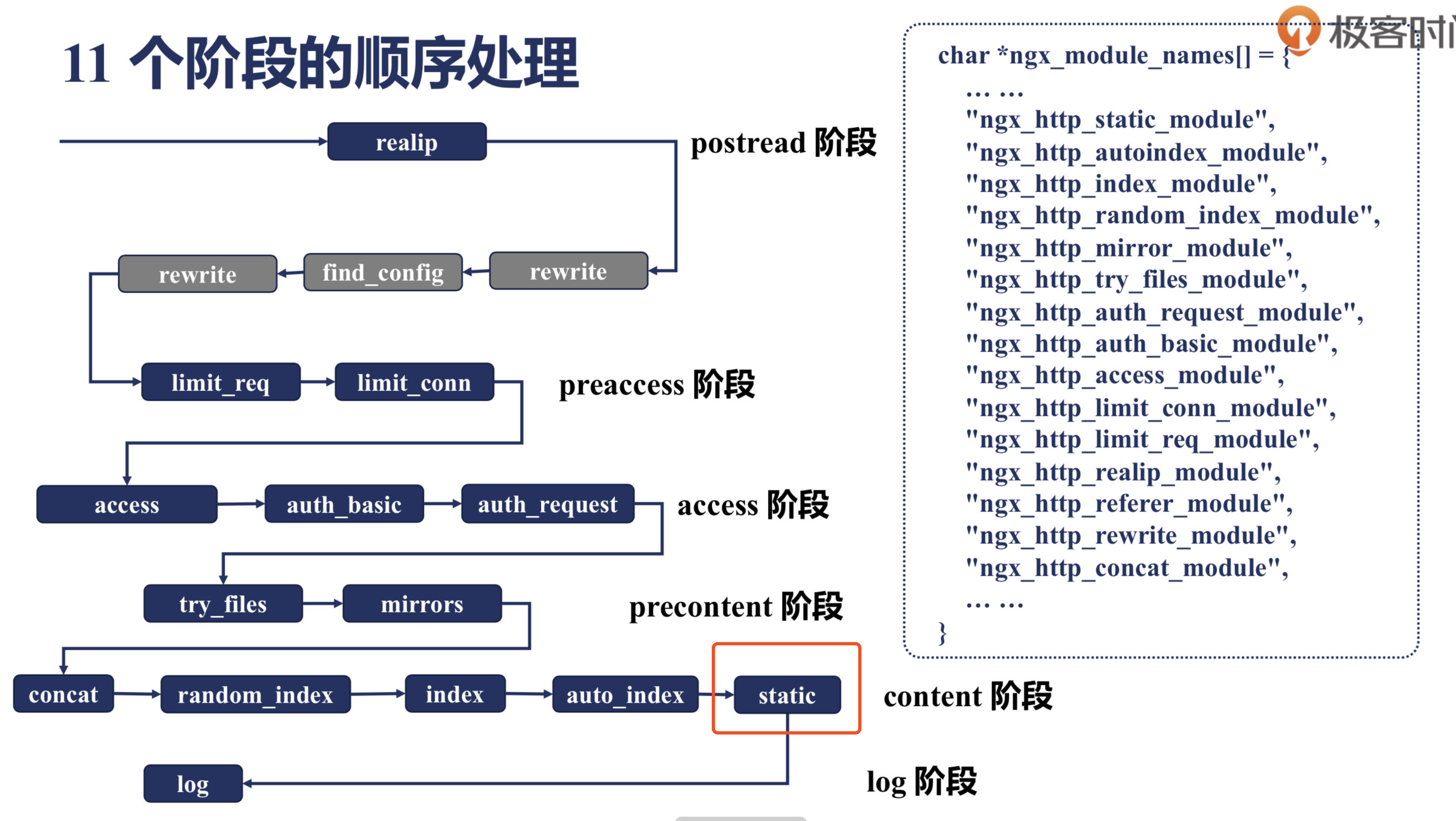相关资料
https://www.cnblogs.com/zhenyuyaodidiao/p/9288430.html
https://openresty.org/download/agentzh-nginx-tutorials-zhcn.html
https://www.cnblogs.com/jackey2015/p/10375549.html
Nginx 处理请求的过程一共划分为 11 个阶段,按照执行顺序依次是 post-read、server-rewrite、find-config、rewrite、post-rewrite、preaccess、access、post-access、try-files、content 以及 log.

内部跳转
所谓“内部跳转”,就是在处理请求的过程中,于服务器内部,从一个 location 跳转到另一个 location 的过程。
既然是内部跳转,当前正在处理的请求就还是原来那个,只是当前的 location 发生了变化,所以还是原来的那一套 Nginx 变量的容器副本。
echo_exec 指令和 rewrite 指令可以发起“内部跳转”。这种跳转会自动修改当前请求的 URI,并且重新匹配与之对应的 location 配置块,再重新执行 rewrite、access、content 等处理阶段。因为是“内部跳转”,所以有别于 HTTP 协议中定义的基于 302 和 301 响应的“外部跳转”,最终用户的浏览器的地址栏也不会发生变化,依然是原来的 URI 位置。
而 ngx_index 模块一旦找到了 index 指令中列举的文件之后,就会发起这样的“内部跳转”,仿佛用户是直接请求的这个文件所对应的 URI 一样。
post-read
最先执行的 post-read 阶段在 Nginx 读取并解析完请求头(request headers)之后就立即开始运行。
支持 Nginx 模块注册处理程序。比如标准模块 ngx_realip 就在 post-read 阶段注册了处理程序。
server-rewrite
post-read 阶段之后便是 server-rewrite 阶段。
当 ngx_rewrite 模块的配置指令直接书写在 server 配置块中时,基本上都是运行在 server-rewrite 阶段。
find-config
紧接在 server-rewrite 阶段后边的是 find-config 阶段。
这个阶段并不支持 Nginx 模块注册处理程序,而是由 Nginx 核心来完成当前请求与 location 配置块之间的配对工作。
换句话说,在此阶段之前,请求并没有与任何 location 配置块相关联。因此,对于运行在 find-config 阶段之前的 post-read 和 server-rewrite 阶段来说,只有 server 配置块以及更外层作用域中的配置指令才会起作用。
rewrite
运行在 find-config 阶段之后的便是我们的老朋友 rewrite 阶段。
post-rewrite
rewrite 阶段再往后便是所谓的 post-rewrite 阶段。
这个阶段也像 find-config 阶段那样不接受 Nginx 模块注册处理程序,而是由 Nginx 核心完成 rewrite 阶段所要求的“内部跳转”操作(如果 rewrite 阶段有此要求的话)。
preaccess
运行在 post-rewrite 阶段之后的是所谓的 preaccess 阶段。
标准模块 ngx_limit_req 和 ngx_limit_zone 就运行在此阶段,前者可以控制请求的访问频度,而后者可以限制访问的并发度。
access
运行在 preaccess 阶段之后的则是我们的另一个老朋友,access 阶段。
标准模块 ngx_access、第三方模块 ngx_auth_request 以及第三方模块 ngx_lua 的 access_by_lua 指令就运行在这个阶段。
post-access
access 阶段之后便是 post-access 阶段。
try-files
紧跟在 post-access 阶段之后的是 try-files 阶段。
这个阶段专门用于实现标准配置指令 try_files 的功能,并不支持 Nginx 模块注册处理程序。
content
Nginx 的 content 阶段是所有请求处理阶段中最为重要的一个,因为运行在这个阶段的配置指令一般都肩负着生成“内容”(content)并输出 HTTP 响应的使命。
log



